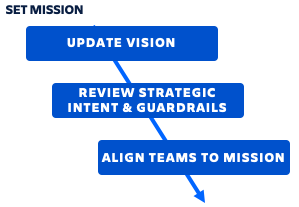Introduction

“Commander’s Intent is the description and definition of what a successful mission will look like…Commander’s Intent describes how the Commander (read: CEO) envisions the battlefield at the conclusion of the mission. It shows what success looks like.” - Chad Storlie (Harvard Business Review)
Program leadership must ensure that at the beginning of every program increment, programs and teams understand what success looks like so they can craft plans to reach that vision. Program mission is similar to the military term “Commander's Intent.”
Decisions to make
- Decide if the vision we’ve established for the program (and/or product) is still accurate, and what the vision is for the next planning period
- Determine how much capacity we have for the upcoming planning period within the program (to use to chase the vision)
- Set expectations on team capacity allocation to the different drivers influencing the next planning period (e.g. "run the business" vs. "build the business" vs. "tech debt")
Context
- A program has been established, and there exists the need to reevaluate the program's vision periodically to ensure we’re still moving in the right direction
- Themes and epics have been established and linked to features, and a rough idea of how much we want to invest in these areas is somewhat understood
- Teams and their capacity have been allocated to the upcoming planning period
Why we care
- Establishing a vision for a program is important as it provides a north star for the teams to steer where we are headed as a program (and why)
- It is equally important to establish a vision for a planning period to help ensure that each planning step a program takes stays in sync with the ultimate program vision (avoids drifting away from the larger vision)
- Visions for the program and planning period will inform how we want to invest our time (and money), meaning we need to determine how we want to spend our time before the planning period starts (for example, building up the business, maintaining the business, or eliminating tech debt)
- Determining how we want to spend our time will ultimately give us direction as to which features should be prioritized for the next planning period
- As we move into the next planning period, rinsing and repeating the cycle of updating our vision to determine what we work on next, it’s import to reflect on how we have invested historically to ensure we make the right business decisions at the right time
The Atlassian view
- Visions can be created, updated, and versioned within Jira Align for programs, planning period (e.g. program increments), and products to connect teams to the direction of the overall organization
- Usage of the “Why” button within Jira Align can help demonstrate to team members (both in Jira and Jira Align) how their works connects to the larger direction of the organization
- Using strategic drivers (associated at the epic level) and allocating a % of each driver to each planning period can serve as a guardrail - how much work the program wants to invest in each area, with a comparison to the actual work done
- Allocating capacity of team members within each team on a program for each iteration/sprint in a planning period allows Jira Align to calculate an approximate cost for the story-level work in the planning period
Next step:
Jobs to be doneWas this content helpful?
Connect, share, or get additional help
Atlassian Community